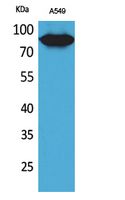CD10 Polyclonal Antibody
- Catalog No.:YT5350
- Applications:WB;IHC;IF;ELISA
- Reactivity:Human;Mouse;Rat
- Target:
- CD10
- Fields:
- >>Renin-angiotensin system;>>Hematopoietic cell lineage;>>Protein digestion and absorption;>>Alzheimer disease
- Gene Name:
- MME
- Protein Name:
- Neprilysin
- Human Gene Id:
- 4311
- Human Swiss Prot No:
- P08473
- Mouse Gene Id:
- 17380
- Mouse Swiss Prot No:
- Q61391
- Rat Gene Id:
- 24590
- Rat Swiss Prot No:
- P07861
- Immunogen:
- The antiserum was produced against synthesized peptide derived from the Internal region of human MME. AA range:491-540
- Specificity:
- CD10 Polyclonal Antibody detects endogenous levels of CD10 protein.
- Formulation:
- Liquid in PBS containing 50% glycerol, 0.5% BSA and 0.02% sodium azide.
- Source:
- Polyclonal, Rabbit,IgG
- Dilution:
- WB 1:500 - 1:2000. IHC: 1:100-1:300. ELISA: 1:20000.. IF 1:50-200
- Purification:
- The antibody was affinity-purified from rabbit antiserum by affinity-chromatography using epitope-specific immunogen.
- Concentration:
- 1 mg/ml
- Storage Stability:
- -15°C to -25°C/1 year(Do not lower than -25°C)
- Other Name:
- MME;EPN;Neprilysin;Atriopeptidase;Common acute lymphocytic leukemia antigen;CALLA;Enkephalinase;Neutral endopeptidase 24.11;NEP;Neutral endopeptidase;Skin fibroblast elastase;SFE;CD10
- Observed Band(KD):
- 85kD
- Background:
- This gene encodes a common acute lymphocytic leukemia antigen that is an important cell surface marker in the diagnosis of human acute lymphocytic leukemia (ALL). This protein is present on leukemic cells of pre-B phenotype, which represent 85% of cases of ALL. This protein is not restricted to leukemic cells, however, and is found on a variety of normal tissues. It is a glycoprotein that is particularly abundant in kidney, where it is present on the brush border of proximal tubules and on glomerular epithelium. The protein is a neutral endopeptidase that cleaves peptides at the amino side of hydrophobic residues and inactivates several peptide hormones including glucagon, enkephalins, substance P, neurotensin, oxytocin, and bradykinin. This gene, which encodes a 100-kD type II transmembrane glycoprotein, exists in a single copy of greater than 45 kb. The 5' untranslated region of this
- Function:
- catalytic activity:Preferential cleavage of polypeptides between hydrophobic residues, particularly with Phe or Tyr at P1'.,cofactor:Binds 1 zinc ion per subunit.,disease:Important cell surface marker in the diagnostic of human acute lymphocytic leukemia.,enzyme regulation:Inhibited in a dose dependent manner by opiorphin.,function:Thermolysin-like specificity, but is almost confined on acting on polypeptides of up to 30 amino acids. Biologically important in the destruction of opioid peptides such as Met- and Leu-enkephalins by cleavage of a Gly-Phe bond. Involved in the degradation of atrial natriuretic factor (ANF).,similarity:Belongs to the peptidase M13 family.,
- Subcellular Location:
- Cell membrane; Single-pass type II membrane protein.
- Expression:
- Adrenal cortex,Brain,Kidney,Placenta,
- June 19-2018
- WESTERN IMMUNOBLOTTING PROTOCOL
- June 19-2018
- IMMUNOHISTOCHEMISTRY-PARAFFIN PROTOCOL
- June 19-2018
- IMMUNOFLUORESCENCE PROTOCOL
- September 08-2020
- FLOW-CYTOMEYRT-PROTOCOL
- May 20-2022
- Cell-Based ELISA│解您多样本WB检测之困扰
- July 13-2018
- CELL-BASED-ELISA-PROTOCOL-FOR-ACETYL-PROTEIN
- July 13-2018
- CELL-BASED-ELISA-PROTOCOL-FOR-PHOSPHO-PROTEIN
- July 13-2018
- Antibody-FAQs
- Products Images

- Western Blot analysis of A549 cells using CD10 Polyclonal Antibody. Secondary antibody(catalog#:RS0002) was diluted at 1:20000

- Western blot analysis of lysate from A549 cells, using MME Antibody.



